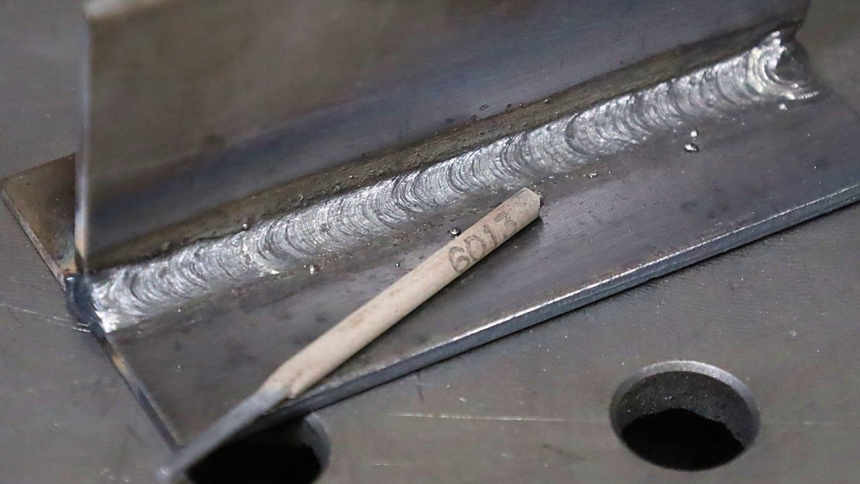Stick welding, also known as Shielded Metal Arc Welding (SMAW), is a versatile and widely used welding process that utilizes a consumable electrode coated in flux to lay the weld. The arc is struck between the electrode and the workpiece, creating intense heat that melts the electrode and the workpiece. The flux coating on the electrode vaporizes, forming a gas shield that protects the molten weld pool from contamination. Stick welding can be performed using alternating current (AC) or direct current (DC), each with advantages and applications.
The Fundamentals of Stick Welding
Stick welding is renowned for its simplicity, portability, and versatility. It can weld various metals, including steel, stainless steel, cast iron, and non-ferrous metals. The process is well-suited for outdoor and harsh environments because the flux coating protects against contaminants like rust, dirt, and moisture. Moreover, stick welding equipment is relatively inexpensive and straightforward, making it accessible to hobbyists and professionals.
AC Stick Welding
How AC Stick Welding Works
In AC stick welder, the current alternates between positive and negative directions, typically at a frequency of 60 Hertz (cycles per second) in the United States. This alternating nature of the current means that the arc is extinguished and re-ignited 120 times per second—the electrode’s polarity changes constantly, which can impact the stability and characteristics of the arc.
Advantages of AC Stick Welding
- Cost-Effectiveness: AC welding machines are generally less expensive than their DC counterparts. This makes them an attractive option for hobbyists and small-scale operations where budget constraints are a concern.
- Arc Blow Reduction: Arc blow, a phenomenon where the arc is deflected from its intended path due to magnetic interference, is less of an issue with AC welding. The constant change in polarity helps mitigate this problem, especially in situations where arc blow is a significant concern.
- Electrode Compatibility: Certain types of electrodes, such as those designed for welding aluminium or materials prone to magnetism, work better with AC. Electrodes like E6011 and E6013 are commonly used with AC due to their ability to penetrate through rust and paint.
- More straightforward Transformer Design: AC welding machines typically have simpler designs and fewer components than DC machines. This simplicity can translate into more excellent reliability and ease of maintenance.
Disadvantages of AC Stick Welding
- Less Stable Arc: The constant extinguishing and re-igniting of the arc can lead to a less stable and more difficult-to-control arc than DC welding. This can make AC welding more challenging, especially for beginners.
- Spatter and Cleanup: AC welding produces more spatter than DC welding, leading to increased post-weld cleanup efforts. This can be a significant drawback in applications where aesthetics and cleanliness are essential.
- Limited Penetration Control: The alternating nature of the current can limit the welder’s ability to precisely control penetration and heat input. This can be a disadvantage when working with thicker materials or when precise welds are required.

DC Stick Welding
How DC Stick Welding Works
In DC stick welding, the current flows in a single direction, either from the electrode to the workpiece (DCEN – Direct Current Electrode Negative) or from the workpiece to the electrode (DCEP – Direct Current Electrode Positive). This unidirectional current flow provides a more stable and consistent arc, which can be easier to control.
Advantages of DC Stick Welding
- Stable Arc: DC welding provides a steady, consistent arc that is easier to control and maintain. This stability translates into smoother weld beads and improved overall weld quality.
- Reduced Spatter: DC welding generally produces less spatter than AC welding, reducing the need for extensive post-weld cleanup and improving the aesthetic quality of the welds.
- Penetration Control: Choosing between DCEN and DCEP allows welders to tailor their welding parameters for optimal penetration and heat control. DCEN provides deeper penetration, while DCEP produces a broader, more uniform bead with shallower penetration.
- Versatility: DC welding is highly versatile and can be used with various electrodes and materials. It is particularly well-suited for welding thinner materials and intricate welds where precision is paramount.
- Better for Overhead and Vertical Welding: DC welding’s stability and control are ideal for out-of-position welding, such as overhead and vertical welds. The consistent arc reduces the risk of defects and improves overall weld integrity.
Disadvantages of DC Stick Welding
- Higher Cost: DC welding machines are typically more expensive than AC machines due to their complex design and additional components. This can be a barrier for those on a tight budget.
- Arc Blow Issues: DC welding is more prone to arc blow, especially when welding materials with high magnetic properties or when strong magnetic fields are present. Managing arc blow requires careful technique and sometimes additional equipment.
- Electrode Compatibility: While DC welding is versatile, some electrodes, such as those designed specifically for AC, may not perform optimally with DC. This can limit the choice of electrodes for specific applications.
Comparative Analysis: AC vs. DC Stick Welding
To determine which welding method is best, it is essential to consider the specific requirements and constraints of the welding project. Here, we compare AC and DC stick welding based on several key factors:
Weld Quality
DC stick welding generally produces higher-quality welds due to its stable arc and reduced spatter. Its ability to control penetration and bead shape more precisely makes it the preferred choice for applications where weld appearance and integrity are critical.
Ease of Use
For beginners, DC stick welding is often easier to master due to its stable arc and consistent performance. AC welding can be more challenging due to the constantly changing polarity and less stable arc. However, with practice, welders can become proficient in both methods.
Cost and Accessibility
AC welding machines are more affordable and accessible, making them popular for hobbyists and small-scale operations. The lower cost can be a decisive factor for those who do not require the advanced capabilities of DC welding.
Application Specificity
The choice between AC and DC can also depend on the specific application:
- Outdoor Welding: AC welding is often preferred for outdoor welding due to its resistance to arc blow and ability to handle contaminated surfaces.
- Precision Welding: For applications requiring precise control and high-quality welds, DC welding is the better choice.
- Material Type: Some materials, such as aluminium, are better welded with AC due to the specific properties of the electrodes used.

Practical Considerations
When deciding between AC and DC stick welding, welders should consider the following practical aspects:
Equipment Availability
The availability of AC and DC welding machines can influence the choice. Suppose a welder already has access to an AC machine. In that case, it may be more cost-effective to use it for suitable projects rather than investing in a new DC machine.
Electrode Selection
Choosing the right electrode for the job is crucial. Some electrodes are designed specifically for AC or DC welding, and using the correct electrode can significantly impact weld quality and performance.
Skill Level
The welder’s skill level and experience should also be considered. Beginners may find DC welding easier to learn and achieve better results. At the same time, experienced welders can adapt to the nuances of both AC and DC welding.
Project Requirements
The specific requirements of the welding project, such as material type, thickness, and desired weld quality, will play a significant role in determining the best welding method. Welders should evaluate these factors carefully to make an informed decision.
Difference between DC and AC welding
| DC Welding | AC Welding |
|---|---|
| The initial cost is high. | AC welding machines cost less than DC equipment. |
| All types of welding electrodes can be welded. | Bare electrodes cannot be used. Only use specially designed coated electrodes. |
| Maintenance costs are higher compared to AC welding. | Lower maintenance costs compared to DC arc welding. |
| Compared to AC, the welding output is smoother. | Weld quality is not as smooth as DC welding. |
| Stable Arc | Unstable arc |
| The heat distribution at the two poles is different [polarity]. | The distribution of heat is uniform. |
| Arc blow is severe. | Arc breakdown will not occur. |
| DC positive electrodes provide greater weld metal penetration. | Less penetration into weld metal. |
| Less spatter | AC welding produces more spatter than DC welding. |
| Straight polarity can weld thinner metals better than AC. | Not recommended for thinner metals. |
| More suitable for overhead welding and vertical welding. | Better with flat-position welding. |
| DC welders are suitable for welding all kinds of metals by changing the polarity. | Usually ferrous material. |
FAQs
1. What is the primary difference between AC and DC stick welding?
The primary difference lies in the type of current used. AC (alternating current) changes direction periodically, while DC (direct current) flows in a single direction. This difference affects arc stability, penetration, and the overall welding experience.
2. Why is DC welding generally preferred over AC welding?
DC welding is preferred for its stable arc, reduced spatter, and precise control over penetration. It provides smoother welds and is easier to handle, especially for beginners and situations requiring high-quality welds.
3. When should I use AC stick welding instead of DC?
AC stick welding is helpful when arc blow is a concern, such as when welding magnetic materials or working in environments with strong magnetic fields. It’s also beneficial for welding on dirty or rusted surfaces and is more cost-effective.
4. Can I use the same electrodes for AC and DC welding?
Some electrodes are designed specifically for AC or DC welding, while others are versatile and can be used with both. It’s essential to check the electrode specifications to ensure compatibility with your chosen welding method.
5. What are the common types of electrodes used for AC welding?
Common electrodes for AC welding include E6011 and E6013. These electrodes are designed to handle the less stable arc of AC welding. They are effective in penetrating rust, paint, and other contaminants.
6. How does arc blow affect welding, and how can it be mitigated?
Arc blow occurs when the arc is deflected by magnetic fields, leading to poor weld quality. It is more common in DC welding. To mitigate arc blow, welders can use AC welding, adjust the electrode angle, or employ techniques like using a shorter arc length.
7. Is AC welding suitable for thin materials?
AC welding is generally less suitable for thin materials due to its less stable arc and difficulty controlling penetration. DC welding is preferred for thin materials because of its precise control and smoother welds.
8. What are the cost implications of choosing AC vs. DC welding?
AC welding machines are typically less expensive and more straightforward in design than DC welding machines. However, DC welding offers better performance and quality, which can justify the higher initial investment for professional and high-quality applications.
9. Can I switch my welding machine from AC to DC or vice versa?
Some advanced welding machines offer AC and DC capabilities, allowing you to switch between the modes as needed. However, most basic machines are designed for either AC or DC only. It’s essential to choose a machine that meets your specific needs.
10. How do I know which welding method to use for my project?
The choice between AC and DC welding depends on various factors, including the type of material, thickness, project requirements, and your skill level. DC is often the better choice for high-quality, precise welds. AC might be more suitable for cost-effective, general-purpose welding, especially on contaminated surfaces.
11. What are the safety considerations for AC and DC welding?
AC and DC welding require proper safety precautions, including using protective gear like helmets, gloves, and aprons. Additionally, ensuring adequate ventilation, grounding the welding machine, and following manufacturer guidelines are crucial for safety.
12. Can I use AC welding outdoors?
Yes, AC welding can be used outdoors and is often preferred due to its resistance to arc blow and ability to weld on contaminated surfaces. However, to maintain weld quality, it’s important to protect the weld area from wind and moisture.
13. What are the typical applications for AC and DC welding?
- AC Welding is ideal for general repairs, outdoor work, and welding on dirty or rusted surfaces. It is commonly used in construction, shipbuilding, and maintenance.
- DC Welding is preferred for precision welding, fabrication, automotive work, and projects requiring high-quality welds. It is also used extensively in manufacturing and industrial applications.
14. How does electrode polarity affect DC welding?
In DC welding, electrode polarity affects penetration and heat distribution:
- DCEN (Direct Current Electrode Negative): Provides deeper penetration and is used for welding thicker materials.
- DCEP (Direct Current Electrode Positive): Produces a broader, shallower bead for welding thinner materials and applications requiring less penetration.
15. What should I consider when buying an AC or DC welding machine?
When purchasing a welding machine, consider factors such as:
- Budget: AC machines are generally cheaper.
- Application: DC is better for high-quality and precise welds.
- Flexibility: Some machines offer both AC and DC capabilities.
- Power Supply: Ensure your power supply is compatible with the machine’s requirements.
- Ease of Use: DC machines are more accessible for beginners due to their stable arc.
16. Can I use AC welding for aluminium?
Yes, AC welding is commonly used for aluminium welding, especially with specific electrodes designed for AC. The alternating current helps break up the oxide layer on aluminium, improving weld quality.
Conclusion
In conclusion, AC and DC stick welding have unique advantages and disadvantages. DC stick welding is generally preferred for its stable arc, reduced spatter, and precise control. It is ideal for high-quality welds and intricate applications. On the other hand, AC stick welding offers cost-effectiveness, reduced arc blow, and suitability for outdoor and contaminated surfaces. The choice between AC and DC stick welding ultimately depends on the specific needs and constraints of the welding project, the skill level of the welder, and the available equipment. By understanding the strengths and limitations of each method, welders can make informed decisions and achieve optimal results in their welding endeavours.










